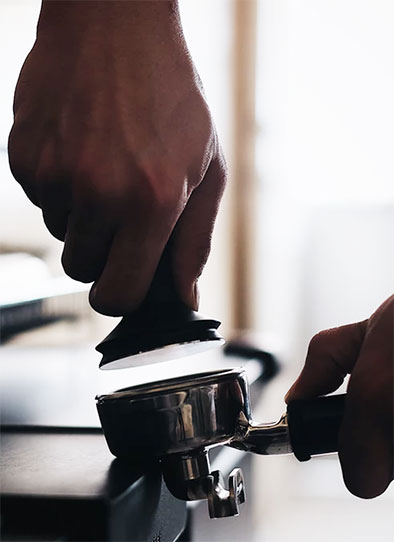How important is proper tamping in espresso?

Anyone who is experimenting with making espresso at home, knows that he has to check many parameters in order to fit into a delightful cup. One parameter as decisive as the other, but often overlooked, is the right tamping
The success of an espresso cup is a process that depends, in addition to the quality of the coffee and the capabilities of the coffee machine, on various variables that we can have full control, such as water temperature, coffee grinding, extraction time and of course the right press of the ground coffee in the machine shutter - otherwise tamping, as is known in the terminology used by coffee lovers.
What is tamping and why is necessary?
By tamping we mean the compressing of ground coffee into the machine's portafilter. The purpose of the "push" is to squeeze the coffee as much as possible, and is achieved by exerting pressure on the coffee with a special tool called tamper. Depending on the dimensions of the portafilter, the corresponding tamper is used, and there are not few professional or amateur baristi who have a whole collection of different tampers.
Coffee tamping is necessary to properly extract an espresso. The reason for making it necessary is the very nature of the extraction. When extracting an espresso, hot pressurized water passes through the ground coffee beans. Water is always looking for the easiest way to escape, so if our coffee is not homogeneous, water tends to pass through its most "fluffy" place, so that only that coffee spot is extracted and the more "tight" is left substantially unaltered. On the other hand, through tamping, we make the water spend more time through the ground grains, and thus extract all the aromas and flavors of the coffee.
What happens if tamping is not right?

If the ground coffee is not "pressed" in the appropriate way, hot water will pass through the grain very quickly or it will only pass through the less "pressed" point. The result will be a sub-extracted coffee, with a weak taste and weak aroma, and its crema will not be the right cream that espresso fanatics love. On the other hand, if our tamping is too tight, the extraction will last for more seconds, which will result in "burning" the coffee - the result will be an espresso that will bitter, less or more depending on temperature of the water we used.
Ηow can we achieve the proper tamping?
- Choose the right tamper. Your tamper should have exactly the same diameter as the portafilter, be ergonomic and be handled with ease.
- Apply the necessary pressure! Espresso fanatics say ideally tamping should be done by applying coffee to a pressure of 15 kg, while others say a pressure of 8-10 kg pounds is enough. If you have any doubts about the pressure, try pressing the presser on a small scale to get the right push.
- Follow the right steps: first press a low pressure, then press the main pressure at least 8 kg and then twist the tamper with soft circular movements.
- Tamp your coffee on a firm surface, as this will make tamping easier and more effective.
- Leave the coffee surface homogeneous: apart from compaction, it is important that the surface of the ground coffee be homogeneous, free of "bumps", so that extraction is correct.
- Experiment a little bit to get the desired result: as the correct extraction of the espresso depends on many factors, it is not a bad idea to keep notes in order to know what you did or did not do well each time to get the experience you need.
Espresso at home is, no doubt, a difficult process: one has to have complete control of temperature, grinding, extraction time and tamping in order to enjoy a delicious cup of coffee. On the other hand, however, these details make the espresso something more than coffee: the right espresso is magic and passion!










